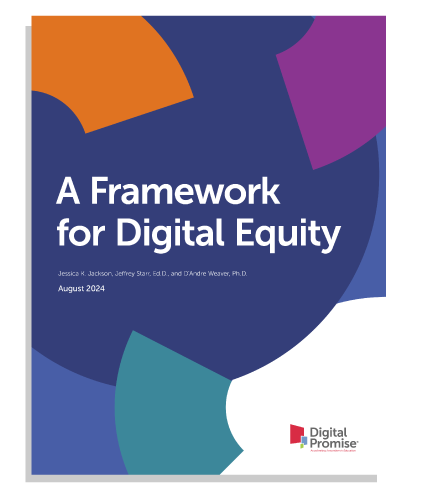Digital equity means everyone has the technology, access, and skills they need to thrive.
K-12 schools serve as a key pathway to digital equity by developing digital literacy, ensuring equitable access to technology, and preparing students for success in the digital age. By fostering equal access and proficiency in navigating the digital landscape, we empower current and future generations. Digital equity is an essential part of preparing all students for future success.

Digital Promise’s Digital Equity Framework is a set of principles, guidelines, and policy recommendations designed to bridge the digital divides at the state level, for K-12 systems, and for higher education. Applied together, it will ensure that all people living, learning, and working in the United States are able to thrive in today’s digital world.
By using the Digital Equity Framework, leaders of school systems and higher education institutions can establish a foundation capable of not only transforming current teaching practices and learning experiences, but also future-proofing their schools for the evolving technological landscape. And, states can use the framework to expand programs to ensure all learners have the opportunity to fully participate in the digital world.
 Dive deeper into the context behind the Digital Equity Framework in our white paper, A Framework for Digital Equity. The publication explains why we believe it’s past time for us to look at digital equity differently than we have before, and why we need new frameworks to achieve it.
Dive deeper into the context behind the Digital Equity Framework in our white paper, A Framework for Digital Equity. The publication explains why we believe it’s past time for us to look at digital equity differently than we have before, and why we need new frameworks to achieve it.
Digital literacy is essential to living and working in today’s society. But digital skill gaps are preventing individuals from reaching their highest potential in the job market, impacting their earning opportunities:
Achieving digital equity means more than having access to devices and the internet. For digital equity to be successful, technology tools have to be available; learners and families have to be able to affordably purchase and maintain them; and learners and families have to have the information and skills to adopt the technology.
These three pillars—availability, affordability, and adoption—must all exist and work together in order for communities to remain connected and fully participate in the society and economy of the United States.
The 2024 National Educational Technology Plan (NETP) frames three key divides limiting the transformational potential of educational technology to support teaching and learning:
Many students experience passive technology use in the classroom, which limits engagement and learning potential. Closing this divide requires active technology use that demands students to think critically, create, and collaborate to develop 21st-century skills.
Unequal access to professional learning opportunities and support creates disparities in educators’ abilities to design effective learning experiences with technology. Closing this divide requires ongoing, job-embedded professional development that builds teacher capacity.
Many students lack access to reliable high-speed internet and devices at home. Closing this divide requires schools to plan for sustainable access and address affordability and adoption barriers.
Let's connect and we'll send you the latest from Digital Promise.